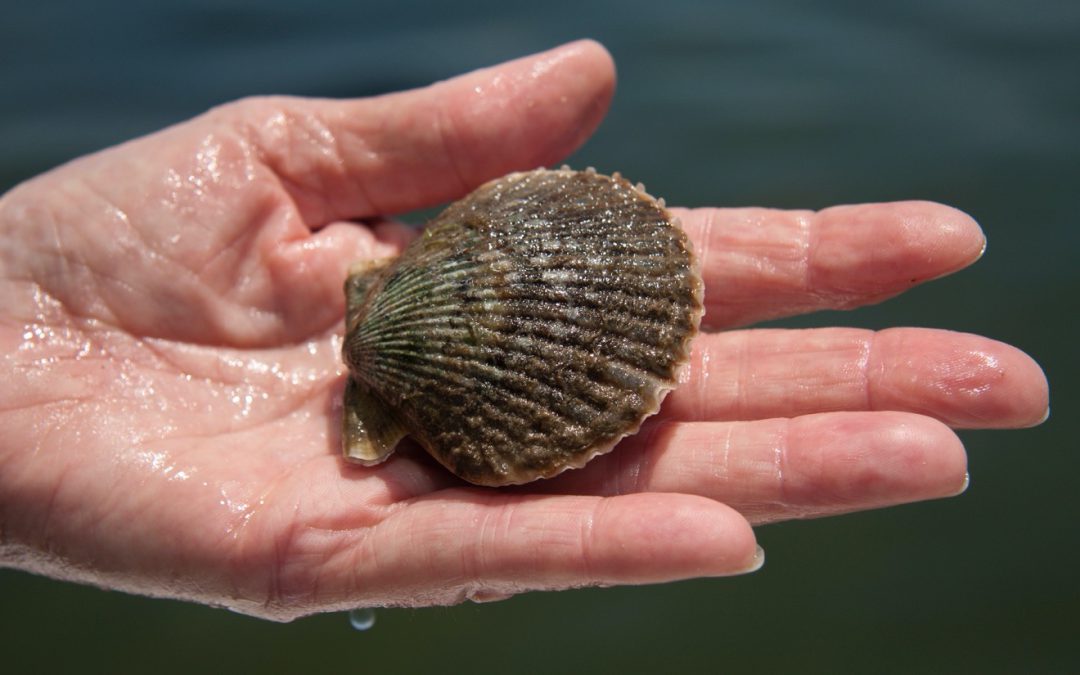
by Rick O'Connor | Jul 1, 2022
One of the programs I focus on as a Sea Grant Extension Agent in Escambia County is restoring the health of our estuary. One of the projects in that program is increasing the encounters with estuarine animals that were once common. Currently I am focused on horseshoe crabs, diamondback terrapins, and bay scallops. Horseshoe crabs and bay scallops were more common here 50 years ago. We are not sure how common diamondback terrapins were. We know they were once very common near Dauphin Island and are often found in the Big Bend area, but along the emerald coast we are not sure. That said, we would like to see all of them encountered more often.

Horseshoe crabs breeding on the beach.
Photo: Florida Sea Grant
There are a variety of reasons why species decline in numbers, but habitat loss is one of the most common. Water quality declined significantly 50 years ago and certainly played a role in the decline of suitable habitat. The loss of seagrass certainly played a role in the decline of bay scallops, but overharvesting was an issue as well. In the Big Bend region to our east, horseshoe crabs are also common in seagrass beds and the decline of that habitat locally may have played a role in the decline of that animal in our bay system.
Salt marshes are what terrapins prefer. We have lost a lot of marsh due to coastal development. Unfortunately, marshes often exist where we would like houses, marinas, and restaurants. If the decline of these creatures in our bay is a sign of the declining health of the system, their return could be a sign that things are getting better.
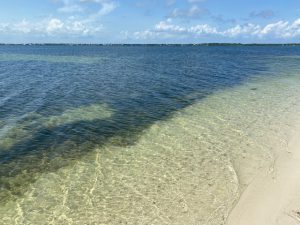
Seagrass beds have declined over the last half century.
Photo: Rick O’Connor
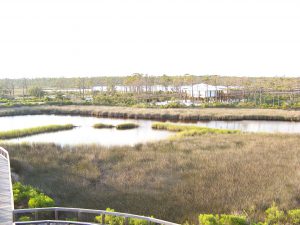
Salt marshes have declined due to impacts from coastal development.
Photo: Molly O’Connor
For over 10 years we have been conducting citizen science monitoring programs to monitor the frequency of encounters of these creatures. All three are here but the increase in encounters has been slow. An interesting note was the fact that many locals had not heard of two of them. Very few knew what a horseshoe crab was when I began this project and even fewer had heard of a terrapin. Scallops are well known from the frequent trips locals make to the Big Bend area to harvest them (the only place in the state where it is legal to do so), but many of those were not aware that they were once harvested here.
I am encouraged when locals send me photos of either horseshoe crabs or their molts. It gives me hope that the animal is on the increase. Our citizen science project focuses on locating their nesting beaches, which we have not found yet, but it is still encouraging.
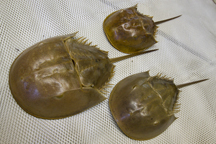
Horseshoe crab molts. Photo UF/IFAS Communications
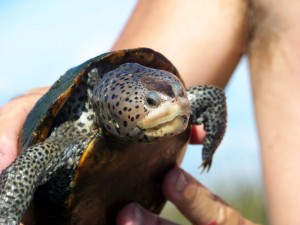
Mississippi Diamondback Terrapin (photo: Molly O’Connor)
Volunteers surveying terrapin nesting beaches do find the turtles and most often sign that they have been nesting. The 2022 nesting season was particularly busy and, again, a good sign.
It is now time to do our annual Scallop Search. Each year we solicit volunteers to survey a search grid within either Big Lagoon or Santa Rosa Sound. Over the years the results of these surveys have not been as positive as the other two, but we do find them, and we will continue to search. If you are interested in participating in this year’s search, we will be conducting them during the last week of July. You can contact me at the Escambia County Extension Office (850-475-5230 ext.1111) or email roc1@ufl.edu or Chris Verlinde at the Santa Rosa County Extension Office (850-623-3868) or email chrismv@ufl.edu and we can set you up.
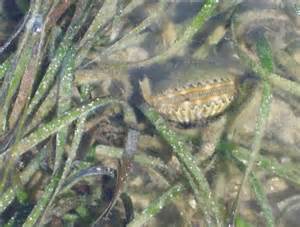
Bay scallops need turtle grass to survive.
Photo: UF IFAS
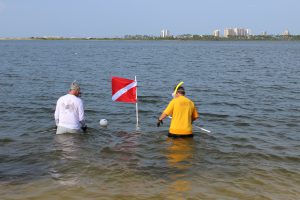
Volunteers participating in the Great Scallop Search.
Photo: Molly O’Connor
Final note…
Each June I camp out west somewhere and each year I look for those hard-to-find animals. After 10 years of looking for a mountain lion, I saw one this year. Finding these creatures can happen. Let’s hope encounters with all three become more common in our bay.

by Rick O'Connor | Jun 23, 2022
“Bluefish!” … “It’s just a school of bluefish!” So yelled the lifeguard in Jaws II when Chief Brody had mistaken a school of bluefish for the rogue great white shark that was plaguing the town. He would not have been the first to mistake these large schools for a larger fish, particularly a predatory shark, but as some know, bluefish are quite predatory themselves.

Bluefish
Image: University of South Florida
Growing up along the Florida panhandle we heard little about this species. We had heard stories of large bluefish schooling along the Atlantic coast killing prey with their razor-sharp teeth and, at times, biting humans. But not much was mentioned about them swimming along our shores. But they do, and I have caught some.
Bluefish are one of several in a group Hoese and Moore refer to as “mackerel-like fish” in Fishes of the Gulf of Mexico. They differ in that they lack the finlets found along the dorsal and ventral sides of the mackerel body and mackerels lack scales having a smoother skin. Bluefish are the only members of the family Pomatomidae. They can reach three feet in length and up to 30 pounds. They travel in large schools viciously feeding on just about anything they can catch and seem to really like menhaden. They move inshore for feeding and protection from larger ocean predators but do move offshore for breeding.
Bluefish landed from the Gulf of Mexico are much smaller than their Atlantic cousins, rarely weighing in more than three pounds. They do have a deep blue-green color to them and thin caudal peduncle and forked tail giving them the resemblance of a mackerel or jack. Some say they are bit too oily to eat while others enjoy them quite a bit. There is a commercial fishery for them in Florida and, as you would expect, it is a larger fishery along the east coast. Most of the panhandle counties have had commercial landings, albeit small ones.
Biogeographically, the blue fish are found all along the Atlantic seaboard and into the Gulf of Mexico. It is listed as worldwide but seems to be absent from the Caribbean and other tropical seas. This could be due to a distaste of warmer waters, or the lack of their prey targets.
They are an interesting and less known fish in our region. Swimming in a school of them should be done with caution, there are reports of nips and bites from these voracious predators.
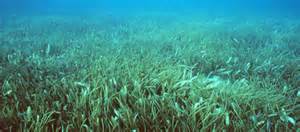
by Rick O'Connor | May 20, 2022
Imagine…
It is 1922 and you are rowing your wooden skiff from a small beach house near what will become the town of Gulf Breeze Florida across Santa Rosa Sound on your way to Santa Rosa Island. The water is 10-15 feet deep, and you can see the bottom. It is covered with a lush garden of seagrasses with numerous silver fish jutting in and out of the blades. Most are there only for a moment before they are lost again. You notice a brown colored puffer fish hovering over the grass as you past by. Maybe a small sea turtle grazing, or a tannish colored stingray flying over the meadow. As you get closer to the island, which is covered with sand dunes reaching 20-40 feet in height and shrubby live oak and magnolia trees, you begin to see Florida conchs and horseshoe crabs, maybe fields of bay scallops littering the grass in every direction.

An amazing meadow of underwater grass.
Photo: Virginia Sea Grant
Sounds amazing, doesn’t it? And it was actually like this once.
What changed?
I asked this question of some ole timers who grew up on Bayou Texar in Pensacola decades ago. You might be surprised to learn that Bayou Texar resembled this scene. They described water that was between 10-15 feet deep, had sand and seagrass on the bottom, and you could catch shrimp the size of your hand by tossing out a cast net. But Bayou Texar no longer looks like this.
Most told me the first thing they remember was a change in the water clarity. The water became more and more turbid. Then the shrimp went away, then some of the fish. They mentioned several species of fish that no longer exist there. The cause of the turbid water? … Development. They were developing all around the Bayou after World War II and that was when things began to change. They mentioned the road going in on the east side of the bayou as the point when turbidity issues began. The houses came later.
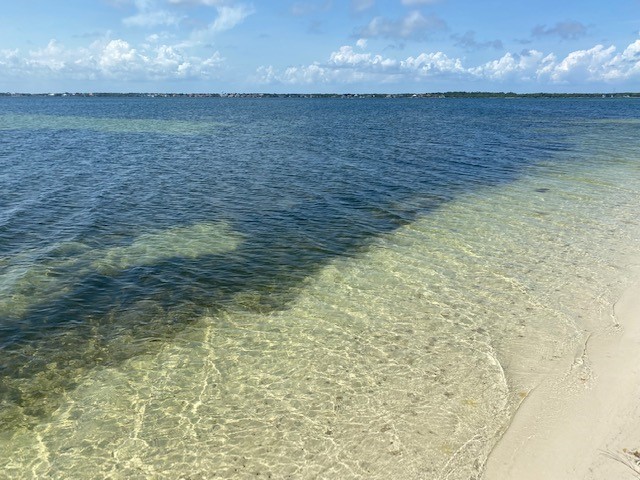
With little rain over the last few days the water clarity was excellent and you could see the seagrass very well.
The city of Gulf Breeze was founded in 1935 and was originally called Casablanca because of a white house there that could be seen from Pensacola. As the community grew the waters became more turbid as well, and the amazing underwater garden declined. But this was not just happening in Gulf Breeze and Bayou Texar, it was happening everywhere.
But it was bound to happen. As the human population grows more space is needed for homes, businesses, and schools. More roads are needed to reach these locations and a bridge was placed to reach Santa Rosa Island, so you no longer had to paddle a skiff to reach it. Once on the island, growth continued. More homes, roads, and businesses. With more run-off, turbidity, and the garden continued to decline.
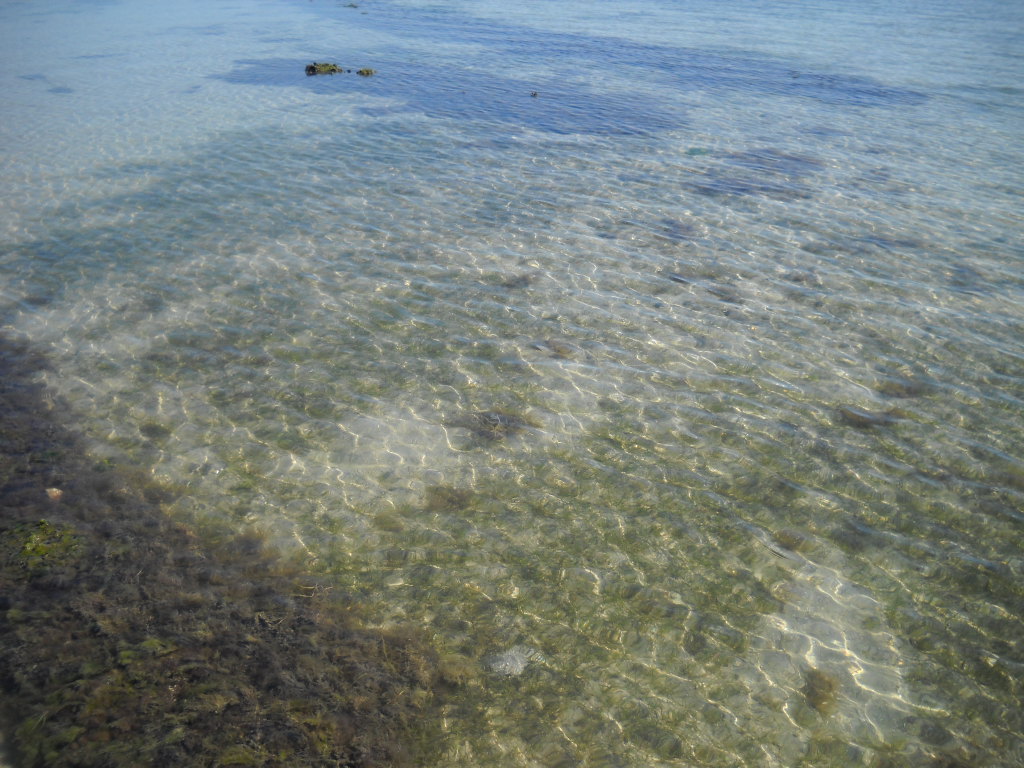
Shoal grass. One of the common seagrasses in Florida.
Photo: Leroy Creswell
The thing was we did not know at the time that (a) we were causing this decline and (b) how much we really wanted that garden there. I often hear the question “what happened to all of the blue crabs?” I think they know the answer, but they remember a time when blue crabs were more abundant, can you imagine what it probably was like for our friend paddling across in 1922. And there has been a noticeable difference in crab numbers in their life. There are folks, including myself, who remember bay scallops in the Sound and horseshoe crabs on what they called “Horseshoe Crab Island” in Little Sabine. This is one of the amazing things about this story – how fast the decline was. Now we better understand how important these underwater meadows were to the function of a healthy estuary and there is interest in restoring them.

Bay scallops need turtle grass to survive.
Photo: UF IFAS
To restore seagrass, you first have to understand, and mitigate, what is causing the decline. Seagrasses are vascular plants that possess roots, stems, and leaves. They produce flowers and sexually reproduce using seed. This is not the case with seaweeds, which are nonvascular and lack the above, but they often mistakenly called seaweeds. There are three species that dominate our seagrass meadows in the Florida panhandle and a fourth one that is not as common. The uncommon one has a round blade like a pine needle and is called manatee grass (Syringodium filiforme).
The three common species all have flat blades. Widgeon grass (Ruppia maritima) has blades that branch. It tolerates a wide range of salinity and is more abundant in the upper regions of our estuaries. Shoal grass (Halodule wrightii) has a single flat, non-branching, blade that is very narrow (< 3mm) and resembles human hair. Turtle grass (Thalassia testudinum) is also flat, non-branching, but wide (>3mm) and resembles St. Augustine grass.
Like other grasses, these plants require sunlight and nutrients to survive. They also need to grow in the low energy locations of our estuaries. Sunlight, of course, is key for photosynthesis and clear water is the key to getting enough of it. 15-25% of the sunlight reaching the surface of the water must also reach the bottom where the grasses are. Nutrients can be obtained through the water column and sediments. The stems run horizontal beneath the sand and are called rhizomes. They help hold sediments in place increasing the much-needed water clarity as well as reduce shoreline erosion. The blades extend from the substrate up into the water column bathing in the sunlight. They are covered by microscopic plants and animals that resemble scum when you run fingers over them but provide mush of the food for the creatures that live there.
And live there they do.
It has been estimated that it least 80% of the commercial and recreational important shell and finfish spend at least part of their lives in the seagrass meadows. Ducks, manatees, and sea turtles are some of the grazers on these plants and sea horses, pipefish, and pinfish are abundant.
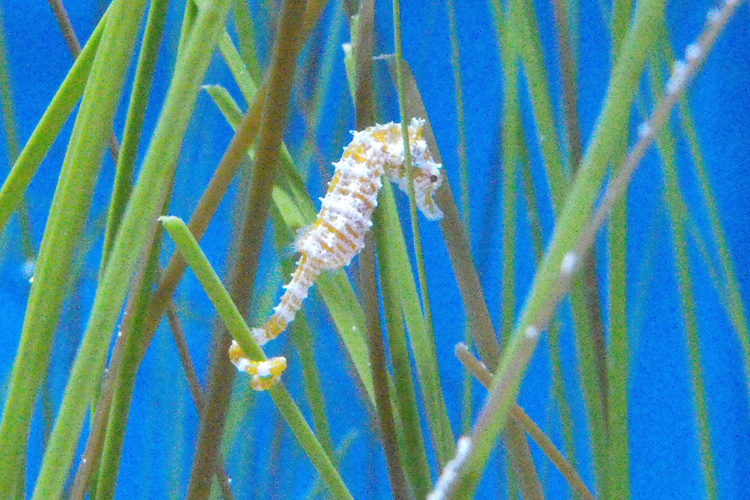
Photo: NOAA
When humans began developing around the Sound in the 1940s and 1950s the sediment run-off decreased water clarity, cutting off the much-needed sunlight, and in some locations covered the grasses. Excessive nutrients from our fertilizers, and detergents increased phytoplankton growth which in turn decreased water clarity more and enhanced the growth of macroalgae which smothered the meadow like a blanket. Hot water discharges from industrial processing along the shores stressed the grasses as did prop and anchor scars from power boat plowing through and anchoring in them. These same boats and jet skis increase wave energy with their wake, as do seawalls when waves reflect off of them. Marinas, bridges, and docks all required dredging in the meadow which not only removed the grasses but increased turbidity even further. All of this triggered the decline of these amazing gardens. And with them the decline of the cherished fisheries as well.
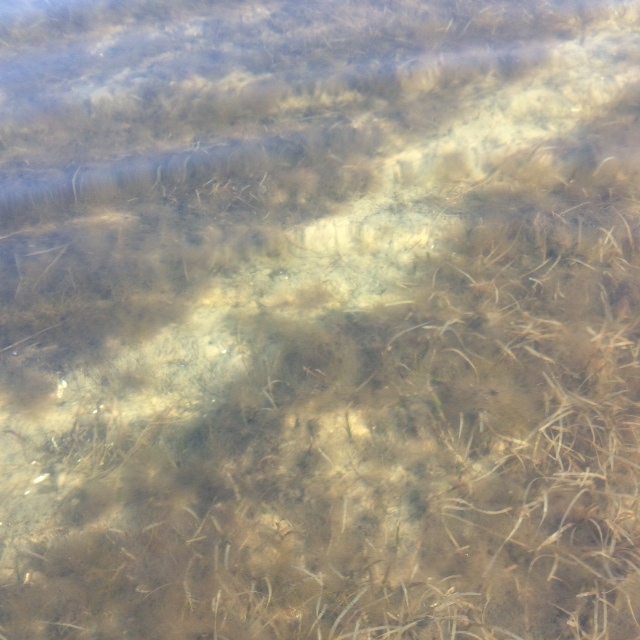
The scarring of seagrass but a propeller.
In recent years the Florida Fish and Wildlife Conservation Commission (FWC) conducted surveys across the state to assess the status of our seagrass beds. They estimated that there was a little over 2 million acres of seagrasses in Florida waters, 39,000 in the western panhandle. Though much of these beds appeared to be stable, or even increasing acreage, those in the panhandle were still in decline and all of Florida’s seagrass gardens were less than the acreage in the 1950s.
In this study they found the Perdido Bay had primarily shoal grass. Big Lagoon and Santa Rosa Sound were a mix of shoal and turtle grass, with some manatee grass reported from Santa Rosa Sound. Aerial imagery found –
Perdido Bay had 642 acres of seagrass in 1987; 125 acres in 2002 for a net loss of 5.4% / year
Pensacola Bay had 892 acres in 1992; 511 acres in 2003 for a net loss of 3.9% / year
Big Lagoon had 538 acres in 1992; 544 acres in 2003 for a net gain of 0.1% / year
Santa Rosa Sound had 2,760 acres in 1992; 3,032 acres in 2003 for a net gain of 0.9% / year
The numbers in the lower portion of the bay are encouraging and suggest some behavior changes we made in recent decades have helped. Both development and monitoring continue. We will see.
What can be done to help restore the garden?
- First, reduce run-off into the bay. This can be done by engineering designs with green infrastructure methods but can also be done by the private homeowner as well. Using native plants in your landscape reduces the need to irrigate your property and landscape designs which include rain gardens and rain barrels will also help reduce run-off.
- The reduction of nutrients begins with the reduction of fertilizers on the landscape. Using Florida Friendly Landscaping principals can lead to a beautiful landscape that does not require fertilizers. If you choose to use nonnative plants that do require fertilizers, use only what the plant needs – do not over do it.
- If you live along the waterfront, you can further reduce nutrients by planting a living shoreline. The plants used in living shorelines are known to remove nutrients from run-off from your property, as well as reduce erosion and provide more habitat for fisheries. One living shoreline project in Bayou Grande has seen an increase in shoal grass beds since they planted it.
- When boating, be aware where seagrasses exist. Lift your motor when moving through them to avoid prop scarring and anchor in open sandy locations. You can also follow the principals of a Florida Clean Boater to reduce your impact on water quality that could impact the seagrasses.
With a little effort on our part, we can enhance some of the positive numbers we have seen in seagrass assessments and hopefully turn the current negative trends into positives. Maybe the garden will return. For more information on how you can apply any of these principals contact your county Extension office.

by Laura Tiu | May 13, 2022
The northwest Florida area has been identified as having the highest concentration of invasive lionfish in the world. Lionfish pose a significant threat to our native wildlife and habitat with spearfishing the primary means of control. Lionfish tournaments are one way to increase harvest of these invaders and help keep populations down. Not only that, but lionfish are a delicious tasting fish and tournaments help supply the local seafood markets with this unique offering.
Since 2019, Destin, Florida has been the site of the Emerald Coast Open (ECO), the largest lionfish tournament in the world. While the tournament was canceled in 2020, due to the pandemic, the 2021 tournament and the Lionfish Removal and Awareness Day festival returned to the Destin Harbor and led to the removal of over 10,000 invasive lionfish.
This weekend, May 14 and 15, 2022, the tournament and festival will be in back in full force at HarborWalk Village in Destin Harbor. A record number of teams will be on the water competing for cash prizes and other loot. Florida Sea Grant will be on hand to support the two-day festival that will include lionfish tasting and fillet demonstrations, conservation and art booths, interactive kids zone, shopping, and lionfish viewing! Bring your family and friends out to support this unique event and do your part to help fight invasive lionfish.
For more information on the tournament, visit EmeraldCoastOpen.com or Facebook.com/EmeraldCoastOpen.
For information about Lionfish Removal and Awareness Day, visit FWCReefRangers.com
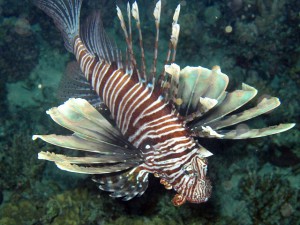
The Invasive Lionfish
“An Equal Opportunity Institution”
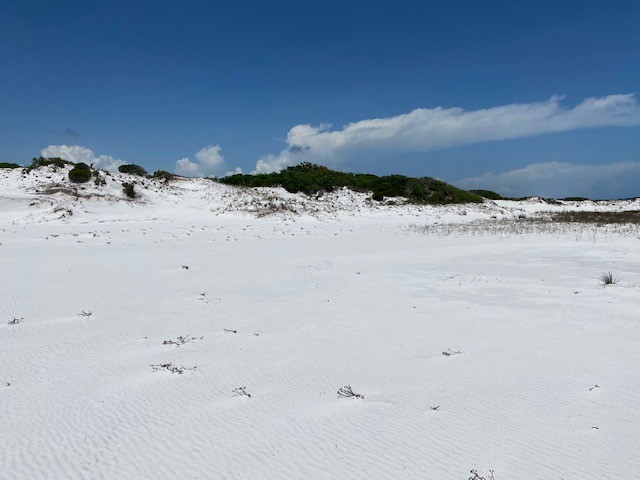
by Rick O'Connor | May 13, 2022
It is mid-spring and time of nesting for much of the wildlife in the area. It is also noticeably warmer than our previous hikes. Due to my work schedule, and the surveys for other nesting activity, I did this hike earlier in the month and later in the day, than I typically would have. I began my hike at 1:00pm – near the hottest part of the day, and not the best time to see wildlife, but I definitely wanted to get a hike in this month and so this is when I could.
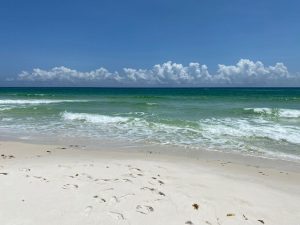
The Gulf was relatively calm on this early afternoon in spring.
It was warm. On this day it was 83°F and there was a light breeze from the southeast. On the previous hikes I needed my fleece. Though I had it in my backpack, I did not need it today. My hike was at Big Sabine and as usual, I began on the Gulf of Mexico. The first thing I noticed when I crossed over the boardwalk was the number of people. I usually hike in the early morning or late afternoon and see few humans. But at mid-day the beach was full of people, and I probably looked strange walking among them with my long pants, long sleeved shirt, and boots. The second thing I noticed was mats of Sargassum on the beach.
Sargassum is a floating brown algae we see in the warmer months in our part of the Gulf. It is first an algae, not a true plant. Algae lack roots, stems, and leaves. They produce no cones, fruit nor flowers with seeds. They are nonvascular, meaning they lack a system of vein-like tubes that move water around the plant. Plants usually do have these tubes. They are not called arteries and veins as they are in animals, but rather xylem and phloem. Because algae lack this circulation system, they live emersed in the water. Since they lack true roots they anchor to hard substrate, like rocks and coral, using a suction type apparatus called a holdfast. The flexible, herbaceous stipe, analogous to the stem, flows in the current extending their blades (analogous to leaves) into the light. Like plants, algae require water, carbon dioxide, and sunlight to photosynthesize their food. Because of this they need to live in relatively shallow water, and they need a rocky bottom to attach their holdfast to. We have little hard bottom and therefore less of the classic algae you read about in other parts of the world.
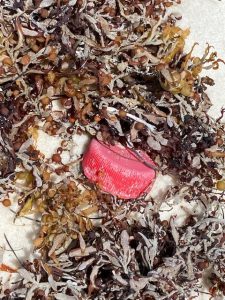
Notice the small air bladders on this Sargassum weed. These are used by the algae to remain near the sunlit waters of the open Gulf.
Sargassum has a different plan to deal with this problem. They float. When you look at this seaweed on the beach you will notice they have numerous small circular air bladders called pneumatophores. These air bladders allow Sargassum to float in the sunlit waters of the Gulf and not worry about how, or where, they would attach their holdfast.
Large mats of Sargassum can be found floating out in the open Gulf and these mats provide a fantastic habitat for many small and large marine creatures. There are sargassum crabs, sargassum shrimp, and even a sargassum sea horse. There is a small filefish and a frogfish known as the sargassum fish. It is the target for baby sea turtles that successfully made it from the beach, through the surf, and into the open Gulf without being consumed. Here they will live and feed for many months at which time they are large enough to venture back out. Larger fish often seek out these mats searching for food, and fishermen seek the mats knowing that larger fish are probably in the area.
These mats of Sargassum get caught in the large ocean currents and find their way to the middle of the Atlantic. Here the ocean is calm, like the eye of a hurricane, and huge mats of Sargassum can be found piled up. Christopher Columbus found this massive expanse of Sargassum while crossing the Atlantic. Because it was calm here, and the Sargassum so thick, his ships became becalmed and he noted in his log to avoid this place, which was then called the “Sargasso Sea”.
On today’s hike there was quite a bit of this seaweed washed ashore. Most of the marine life living in the seaweed sense the waves and the impending beaching, and jettison for mats further offshore. So, you usually do not find many creatures in the seaweed washed ashore, but sometimes you do. You can take a small dip net out deeper and grab some still floating and you may have better luck. Today, I explored what was washed ashore and did not find much. I did find a lot of plastic, and those who study Sargassum ecology will tell there is a lot of plastic debris caught up in the Sargassum mats. Today I noticed a lot of bottle caps. Not many bottles, but lots of bottle caps. As many others do, we encourage everyone to dispose of the garbage properly. I read this week of a manatee found near Mobile Bay earlier this year who died of cold stress but had swallowed a plastic bag, which was caught in his throat. Marine debris kills. Please dispose of your trash properly.
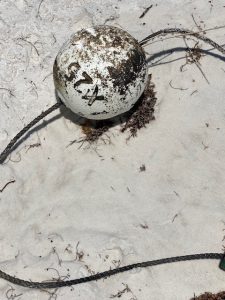
This crab pot float was one of several debris items washed in with the sargassum.
Heading inland to the dune field I heard sirens. The beach patrol was answering a call. I am not sure where, nor what the issue was, but these again are sounds I do not usually hear when hiking early and late in the day. There are currents in the Gulf that can suck you out to sea, and each year we have visitors drown not knowing where these currents are, or how to get out of them if they are caught in one. Pay attention to the colored flags and be careful. I never saw, nor heard, an ambulance follow the beach patrol. So, I am guessing everyone was okay on this call.
The dune field on this May afternoon was warm. There was a light breeze from the southeast that kept things from getting too warm, but it was warm none the less. As we move closer the hot days of summer the wildlife will move more at dawn and dusk, as well as in the evening. I was not expecting to see a lot on this hike.
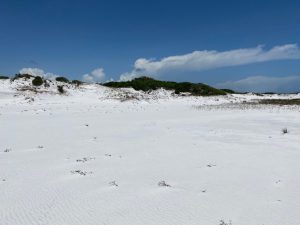
This flat area of the dune field was quite warm on this afternoon and made me think of crossing a desert.
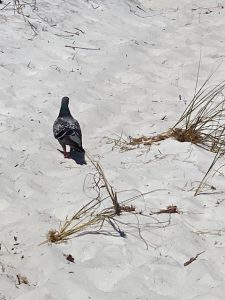
This was an unusual site, a pigeon walking in the open dune field.
As always you can see what has been moving by searching for tracks and tracks, I did find. Many of them were human, indicating the tourist season is upon us, but there were tracks of animals as well. There were plenty from our friends the raccoon and armadillo. I did notice more raccoon tracks this month. I and my volunteers who survey nesting beaches notice more raccoon tracks this time of year looking for eggs. I also noticed more snake tracks on this hike, they too are mating and moving much more. The lizard tracks were fresh, and I have noticed these moving during the warmer parts of the day and their tracks running across the dune face told me they were very busy that day.
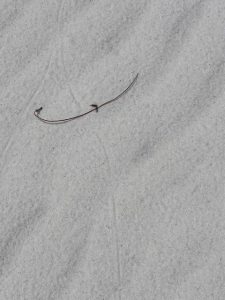
This straight line the sign of a tail drag by a lizard, most likely the six-lined skink.
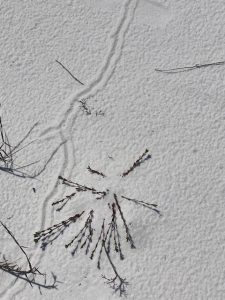
Many who visit the dunes of our barriers find these burrow looking trails. These are made by beetles.
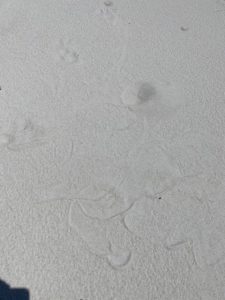
I followed this snake track until I found this – what appears to be a “tussle” the snake had with a possible prey.
Being spring you would expect flowers, and there were some, just not as many as you might expect. Most of them were white and were blooming on plants near the boggy areas of the swales. The conradina that blooms more in the winter, was done and the blossoms were gone. I did see the early stages of the magnolia flowers trying to come up, but the bright green shoots of new growth on the pines were not visible. There were bees, lots of bees.
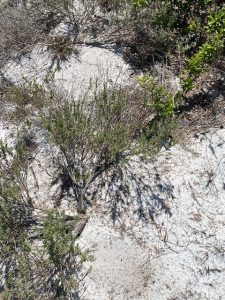
The lavender blossoms of the false rosemary, which appeared in winter, are now gone.
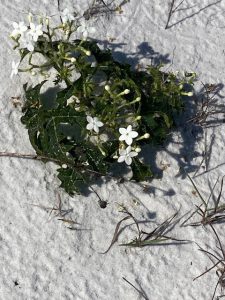
White flowers were common on this spring afternoon. Such as this one on the spiny bull nettle.
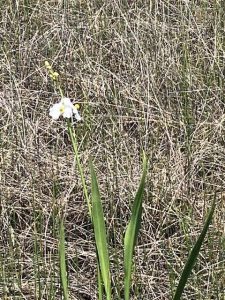
Another white flower is seen on this Sagittaria growing in one of the swales between dunes.
I hiked through a small pine scrub area thinking I might someone in the shade avoiding the heat of the day but did not find anything. I went along the edge of the tertiary dunes where they meet the maritime forest looking for the same thing. Nothing, but there were tracks. The cactus seemed to be more abundant this month.
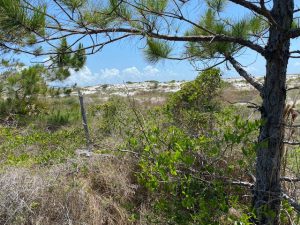
The pine scrub offered one of the few places with shade.
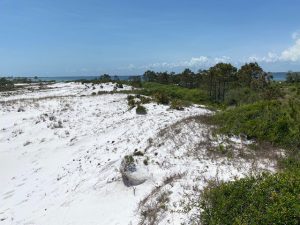
The dune field of a Florida panhandle barrier island.
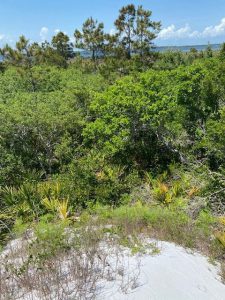
From atop of one of the higher dunes you can see the steep drop towards the marsh.
Along the ridge between the maritime forest and the salt marsh is where I found the otter slide last month. I did not see any evidence of otters today. The bird action was slower today as well. Maybe because of the heat they too had settled somewhere. I did not see an osprey, which is unusual.
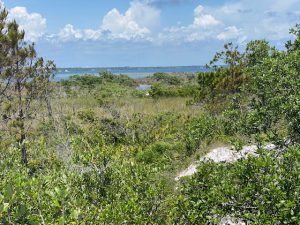
Big Sabine as seen from atop one of the larger dunes.
As I reached the beach of the Sound, I did notice a LOT of digging by armadillos. They had been very active. There were no snakes or marsh rats. There were again people, these were on jet skis. There were a few fishing from small boats. With no rain over the last week or so the visibility in the Sound was amazing, but I only saw one small blue crab. No hermit crabs and not any fish. However, the lagoon of the marsh the killifish, also known as bull minnows, were abundant and the males all aglow with their iridescent blue colors of breeding season. The males were chasing each other all over the tidal pools and open water of the lagoon designating their territories for current breeding that would follow. I did notice more crows than I usually do and what made me catch their attention was the constant calling at me and the hovering over me suggesting they too were breeding, and an active nest was nearby.
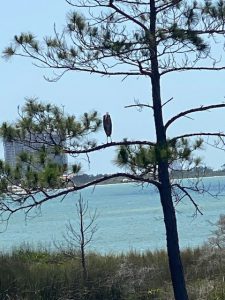
A blue heron is seen sitting in a pine overlooking Santa Rosa Sound.
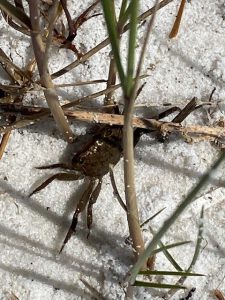
A small Seserma crab is seen hiding under grass along the beach of the Sound.
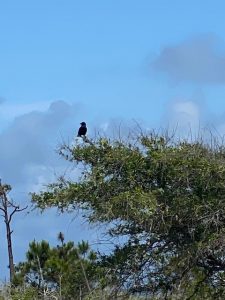
The crows were numerous and active on this spring afternoon.
I was not expecting much hiking in the middle of the afternoon, but it is always good to do these just to see what is moving. I hope to do another hike this month either early in the morning or late in the afternoon. Maybe we will see more.
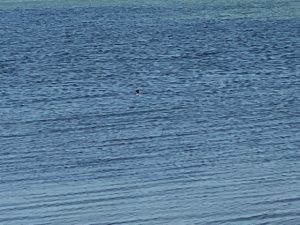
It may be hard to see, but there was a small duck enjoying the Sound.

With little rain over the last few days the water clarity was excellent and you could see the seagrass very well.

by Rick O'Connor | Apr 21, 2022
It is now spring, and wildlife is beginning to stir more. However, on this April day another cold front had just past the area and the morning temperature was 59°F. To add to this, there was a strong west wind that made it feel colder. Despite the fact it was an early spring morning in Florida, I had my fleece on and was dubious that I would see any reptiles.
This month’s hike was out at Big Sabine near Park East. The Gulf of Mexico was churning like a washing machine due to the passing front and the beach had a sharp scarp to it. There were a few plovers out trying to probe the sand for food, but not much else. Usually after hard winds you will find an assortment of things washed up on the beach but there was little really, possibly removed by the storm. There were however signs of digging by humans. It is now sea turtle nesting season, and we remind folks that these large holes can be a real problem for the mothers trying to nest. Please fill them in before you leave the beach.
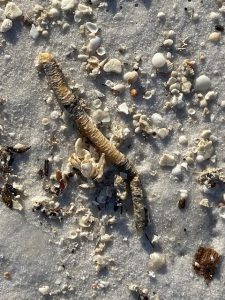
Diopatra are segmented worms similar to earthworms who build tubes to live in. These tubes are often found washed up on the beach.
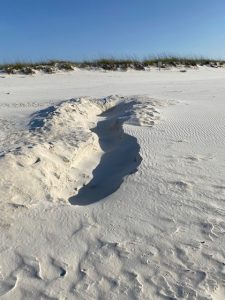
Large holes like this can be problematic for many island wildlife species – like nesting sea turtles. Please fill them in when you leave for the day.
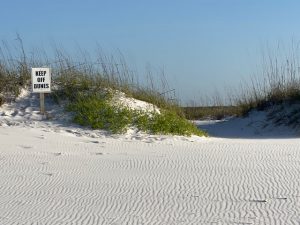
“Blow outs” are formed by people walking over the dunes. They will increase the erosion of these dunes and enhance flooding during storms. Please cross over on boardwalks.
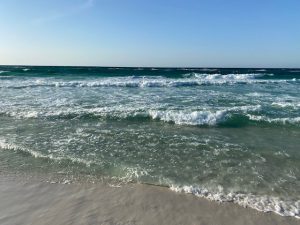
The Gulf of Mexico was churned up due to the passing cold front.
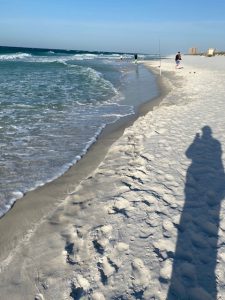
Beach scarps are formed during heavy surf changing the dynamics of the beach for creatures living there.
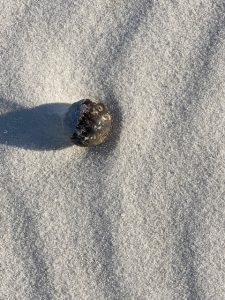
“Sea Beans” are seeds of tropical plants that wash ashore this time of year. Most do not germinate and those that do are usually on a high energy beach and do not survive.
As you head north into the dune fields the wind typically slows, but this morning it was blowing plenty hard, and I was getting “sand blasted” at some points. Not the best day to find wildlife. The sun was out and I decided to check the leeward side of shrubs and bushes, but had no luck.
One thing I did find was the sandhill milkweed in bloom. This plant is host to the monarch butterfly caterpillars and produces a mildly toxic “milk” which the caterpillars accumulate making them toxic to birds. This toxin is carried on to the adult butterfly stage and many birds learn to avoid butterflies with the monarch coloration because of the bad taste. Though I saw lots of milkweed, it was too windy for the butterflies.
The blooms of the false rosemary, which appear in late winter, had all fallen but it was obvious that the pine trees had release their pollen. Most of the scrubby pines in the dunes had new growth on them.
There were several ephemeral ponds scattered amongst the dunes. All had water in them from the recent rains and I was hoping to maybe find a basking snake or singing frog. No luck on either. There were damp areas where water had recently been, and the carnivorous sundews and spore producing club moss, known as ground pines, were doing very well.
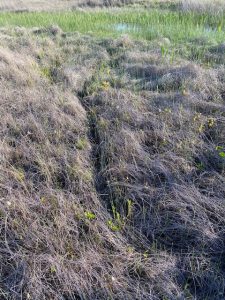
The path used by wildlife to reach the ponds of the dune field.
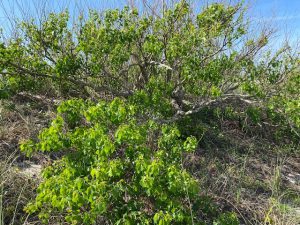
Two invasive Chinese tallow trees were found growing in the dune field. These will be removed.

Devil’s Joint is a common cactus in the dunes. Wear shoes when exploring!
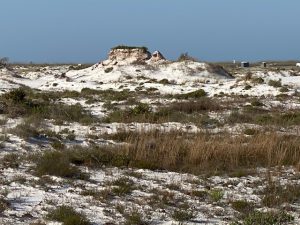
The high winds of the beach can form some interesting dunes. This one resembles the mesa’s of the American southwest.
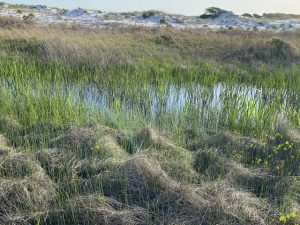
There are numerous freshwater ponds in the low areas of the dune field. Many of them are ephemeral.
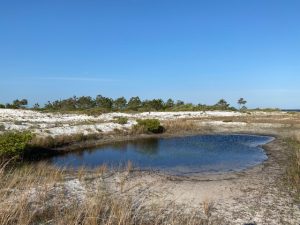
Freshwater ephemeral pond.
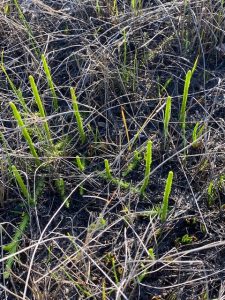
Ground pine is a type of club moss found in the wet-damp areas of the dunes.
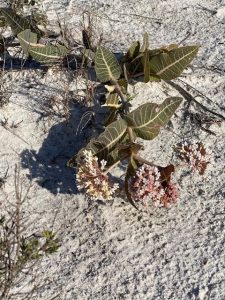
The sandhill milkweed is bloom this time of year.
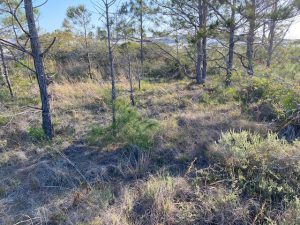
Pine scrub areas like this are found in the dune fields and are great places to find snakes and lizards.
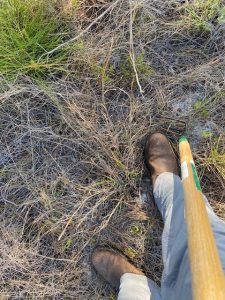
Since some of our snakes are venomous, it is recommended you wear good boots and have a hiking stick to move logs and high grass before stepping in or over.
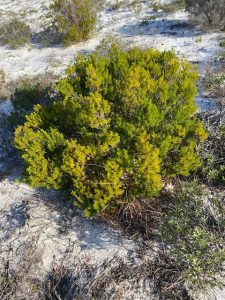
Seaside rosemary produces a wonderful smell that reminds many of the beach.
As I moved from the dunes into the maritime forest, I was expecting to see birds. I did, but not many. Most were small woodland birds I could not identify, and there was an osprey flying over briefly, but for the most part the bird action was slow today – again, probably due to the high winds. I was again hoping to maybe find a basking snake on the sunny leeward side of a bush or fallen tree but had none. I did find a common parasitic plant that was becoming more common this time of year. It is called “love-vine” or dodder. This yellow-colored string looking vine lacks chlorophyll and wraps around host plants to remove much needed nutrients. It begins to appear this time of year and is not restricted to the beaches. I have seen it 10 miles inland.
One thing that was very evident in the maritime forest was sign of armadillos. Their tracks and digs were found everywhere. I did locate a few burrows and found even more along the beach of the Sound. These animals are very abundant on this island I am curious as to what predators they have and how their populations are controlled. They can be found day or night and dig frequently looking for grubs and other invertebrates to eat. Whether they seek out turtle or bird eggs I do not know. More on this guy next month.
I will add that I did see tracks of raccoons who do eat turtle eggs and also what I think was a “slide” of an otter. The number of otter encounters has increased in recent years. Individuals have been seen not only on the beach but around Bayou Texar and Project Greenshores. These are very elusive animals and produce a high pitched “chirp” or “bark” when approached. I have seen them near Ft. Pickens on a couple of occasions in the ponds. There are the old hatchery ponds at Big Sabine, and it was there that I found the “slide”. These slides are used by the otters to slide into the water. I have seen video of them exiting the water, sliding back in, only to repeat this as if they were playing like kids – and I think that is what they are doing… playing. Otters are the largest members of the weasel family, mustelids, and pretty cool.
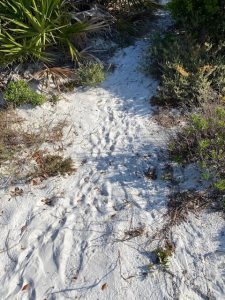
Many creatures use the same trails we do. This is a good place to look for tracks.
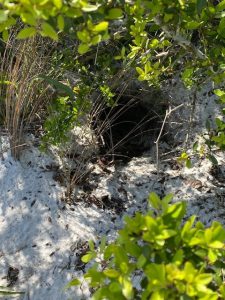
Armadillos are all over the island. This is a burrow of one.

The digging of armadillos can be found everywhere as well.
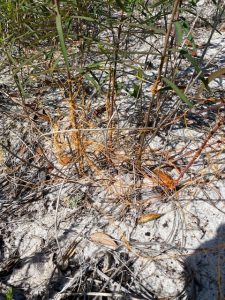
Dodder (or “love vine”) is a parasitic plant that begins to appear this time of year.
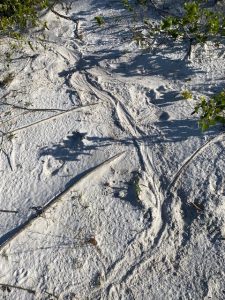
This is what I think to be an otter slide. Though I could not find tracks to confirm, I have seen them build and use these before.
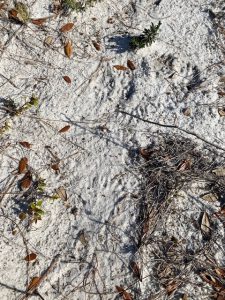
Raccoons are common all over the island.
The marsh of Big Sabine was pretty quiet on this windy day. I did see two Canadian geese walking along the shore. I recently saw several nesting on an island in Okaloosa County and was told they were now year-round residents. I am not sure whether these were residents to Big Sabine or not, I had not seen them before, but will note this as this series continues this year.
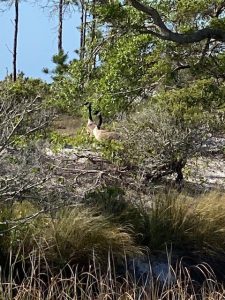
Canadian geese are becoming residents on some islands along the panhandle.
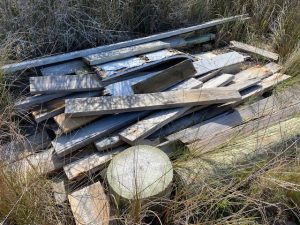
Wood piles like these can be good habitat for some beach wildlife.
The beach of Santa Rosa Sound was quiet as well. Again, I probed around to seeking a basking snake, a nesting terrapin, or maybe a nesting horseshoe crab (it was a spring tide day) but found nothing. There are piles of wood gathered by locals cleaning the beach and these actually make good habitat for some wildlife. I poked around in them but did not find anyone today. This was also where I found most of the armadillo burrows. Why they preferred this over the forested areas I am not sure. There may be many more in the forest that I just did not see. The spring tide was rising and much of the beach was exposed but I saw no fiddler crabs or other creatures and there was nothing swimming nearshore in the grass beds. Again, the lower temperatures and high winds I am sure had everyone in a warmer calmer place.
Despite little wildlife today it was a great walk and despite the high winds, the weather was actually nice. It is spring and nesting should be going on across the island. We will visit Ft. Pickens in May and see what is going on then.
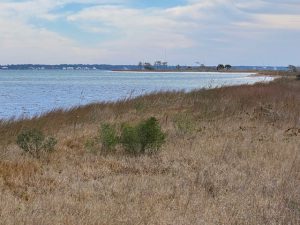
Santa Rosa Sound.































































